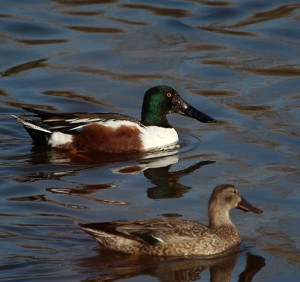
by John Shackford
Now a bit about the Northern Shoveler. A. C. Bent, in Life Histories of North American Wild Fowl (1987 Dover edition) stated that the Northern Shoveler “is one of the best known and the most widely distributed ducks in the world…it is universally common over nearly all of the continents of North America, Europe, and Asia…” Further, he adds, “It is essentially a freshwater duck at all seasons, never resorting to the seacoasts except when forced to by stress of weather…” The shoveler is no longer so widespread over North America as when Bent made his statement about the species covering most of the continent. Its strongholds in North America now are the northwest part of the continent well into Alaska. The most noticeable feature for quick identification of this species is a bill that looks like a spatula, wide and long for a duck. This exaggerated bill is noticeable not long after the young hatch.
In Oklahoma, according to Sutton (1967, Oklahoma Birds) they “breed in small numbers, principally on Salt Plains National Wildlife Refuge in Alfalfa County.” Sutton also stated, “Many midsummer records for nonbreeding birds: about two hundred seen repeatedly at Salt Plains refuge in 1952,” reported to Sutton by J. B. Van den Akker. The shoveler, according to Bent, usually lays 10-12 eggs but this can vary from at least as low as 6 or as many as 14. The nest is made of dry grasses, and may be well away from water, but usually not too far from it. The interior of the nest has down for a lining and this appears to be added to as incubation progresses. But primarily the shoveler is a spring and fall migrant for us in central Oklahoma, some of which layover in the state through the winter. The numbers we find locally in winter seem to be increasing, as are the numbers of several other species normally found to the south of us in winter. We found 316 shovelers on our recent Christmas Bird Count, which is the third highest CBC record for us.
